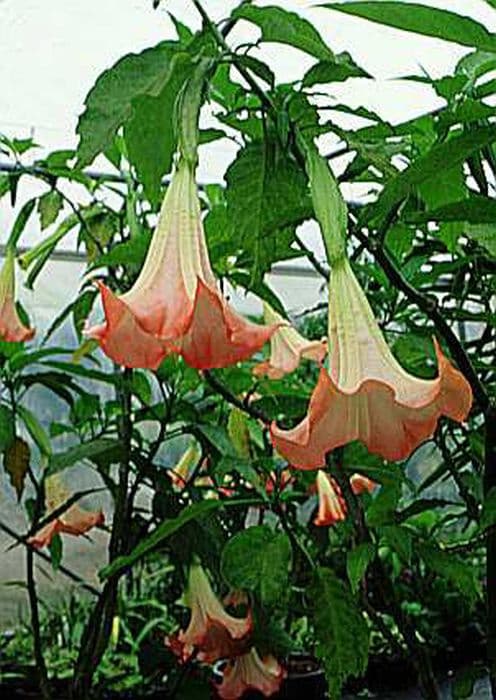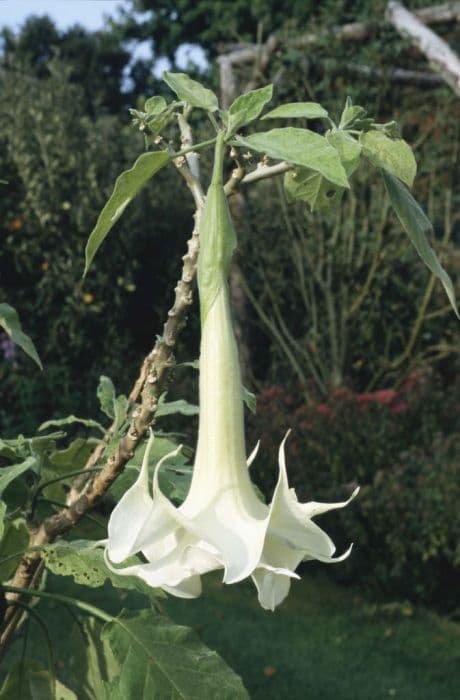Million Bells Calibrachoa Caloha Classic Yellow Chocolate Ring (Caloha Classic Series)
![calibrachoa [Caloha Classic Yellow Chocolate Ring]](/_next/image?url=https%3A%2F%2Fplants-admin.emdemapps.com%2Fimages%2Fplants%2F%2Fimages%2F604b538aede95.png&w=3840&q=75)
ABOUT
The Calibrachoa Caloha Classic Yellow Chocolate Ring, belonging to the Caloha Classic Series, is a striking flowering plant known for its unique two-tone flowers. The blooms are characterized by their vibrant, sunshine yellow petals that graciously blend into a distinct, dark, chocolatey ring at the center, giving the appearance of a rich, eye-catching contrast. The trumpet-shaped flowers are small and abundant, covering the plant in a shower of color that is highly attractive. The plant itself has a lush, green foliage which serves as a perfect backdrop to the bright flowers, emphasizing their beauty. The cascading stems of the plant make it an ideal choice for hanging baskets or as a spiller plant in mixed containers, where the vibrant yellow and chocolate hues can trail gracefully over the edges.
About this plant
 Names
NamesFamily
Solanaceae
Synonyms
Million Bells, Mini Petunia
Common names
Calibrachoa Caloha Classic Yellow Chocolate Ring.
 Toxicity
ToxicityTo humans
The plant commonly known as Million Bells is not known to be toxic to humans. It is generally considered safe, and there are no well-documented reports of poisoning from ingestion of any parts of this plant. However, it's still advisable to avoid eating ornamental plants as they are not intended for consumption and their effects may not be fully researched or understood.
To pets
Million Bells is not listed as toxic to pets. It is generally safe around cats and dogs, and there are no significant reports of pets being poisoned by consuming parts of this plant. Still, as with all ornamental plants, it is best to prevent pets from ingesting them as they may cause mild gastrointestinal upset or an allergic reaction in rare cases due to the individual sensitivities of certain animals.
 Characteristics
CharacteristicsLife cycle
Annuals
Foliage type
Evergreen
Color of leaves
Green
Flower color
Yellow Chocolate
Height
1-2 feet (30-60 cm)
Spread
1-2 feet (30-60 cm)
Plant type
Herb
Hardiness zones
9
Native area
South America
Benefits
 General Benefits
General Benefits- Attractive Blooms: Features striking yellow flowers with a contrasting chocolate center, adding visual interest to gardens and landscapes.
- Long Flowering Period: Blooms continuously from spring to fall, providing color throughout multiple seasons.
- Low Maintenance: Requires minimal care once established, making it a suitable choice for busy or novice gardeners.
- Versatile Use: Suitable for hanging baskets, window boxes, containers, and as a bedding plant, offering various gardening options.
- Drought Tolerant: Capable of withstanding periods of low water once established, reducing the need for constant watering.
 Medical Properties
Medical PropertiesThis plant is not used for medical purposes.
 Air-purifying Qualities
Air-purifying QualitiesThis plant is not specifically known for air purifying qualities.
 Other Uses
Other Uses- Creating a Living Art Piece: Calibrachoa's vibrant yellow and chocolate ring blooms can be arranged in patterns to create outdoor live wall art or hanging botanical tapestries.
- Photography Backdrops: The contrasting colors of the Calibrachoa flowers provide a unique and eye-catching background for macro or portraiture photography.
- Educational Tool: The plant can be used in schools or educational programs to teach children about plant growth, hybridization, and the importance of pollinators.
- Mood Enhancement: Due to their bright and cheerful appearance, placing Calibrachoa in a living or working space can improve mood and create a more positive environment.
- Themed Parties: The distinct color pattern of the Calibrachoa can complement specific party themes, especially chocolate-themed events or springtime celebrations.
- Bath Bombs: The petals of Calibrachoa, once dried, can be used as a natural decorative element in homemade, biodegradable bath bombs.
- Handmade Paper: Incorporating dried Calibrachoa petals into handmade paper can provide an attractive texture and color for craft projects.
- Eco-friendly Confetti: Dried petals of Calibrachoa can be used as a natural and biodegradable confetti alternative for weddings or celebrations.
- Culinary Garnish: While not typically used for consumption, the colorful blooms can serve as an ornamental garnish to enhance the presentation of dishes in upscale culinary settings.
- Crafting Natural Dyes: The pigments from Calibrachoa flowers can be used to create natural dyes for fabric, yarn, or other crafting materials.
Interesting Facts
 Feng Shui
Feng ShuiThe Calibrachoa is not used in Feng Shui practice.
 Zodiac Sign Compitability
Zodiac Sign CompitabilityThe Calibrachoa is not used in astrology practice.
 Plant Symbolism
Plant Symbolism- Celebration: The bright yellow color of the Million Bells reflects joy and festivities, making it a popular choice for celebratory occasions.
- Creativity: The unique chocolate ring pattern in the center of the flowers symbolizes originality and the flowering of new ideas.
- Warmth and Sunlight: Just like sunshine, the plant's vibrant yellow hue brings warmth and positive energy to any setting.
- Friendship: Yellow flowers often represent friendship and strong social bonds, suggesting the plant could be a good gift between friends.
- Happiness: Its cheery appearance is frequently associated with happiness and can be used to brighten someone's day or living space.
 Water
WaterMillion Bells require consistent moisture but don't like to be waterlogged. Water them thoroughly when the top inch of the soil feels dry to the touch. During hot, dry periods, this may mean watering daily. Ensure adequate drainage to prevent root rot. Generally, aim for about 8-16 ounces of water per plant every week, adjusting for rainfall, temperature, and soil type.
 Light
LightMillion Bells thrive in full sunlight for best blooming. Position the plant in a spot where it will receive at least 6 to 8 hours of direct sunlight each day. While they can tolerate partial shade, too little light will reduce their blooms and vibrant colors.
 Temperature
TemperatureMillion Bells prefer warm temperatures and perform best in conditions ranging from 55 to 85 degrees Fahrenheit. They can tolerate a low of around 40 degrees Fahrenheit but will suffer if temperatures drop below freezing. The ideal temperature range for these plants is between 60 and 75 degrees Fahrenheit.
 Pruning
PruningPrune Million Bells to encourage bushier growth and more blooms. Trim back leggy stems throughout the growing season to maintain the plant’s shape. The best time for pruning is in late spring or early summer before the plant reaches peak bloom. Pruning every few weeks can help maintain vigor and aesthetic appeal.
 Cleaning
CleaningAs needed
 Soil
SoilMillion Bells prefer a light, well-draining potting mix with a pH between 5.6 and 6.2. A mix of peat moss, perlite, and compost is ideal for maintaining the necessary balance of moisture and aeration.
 Repotting
RepottingMillion Bells should be repotted annually to refresh the soil and provide room for growth, typically in the spring before the new growth starts.
 Humidity & Misting
Humidity & MistingMillion Bells thrive best in moderate to high humidity levels but are adaptable to normal outdoor humidity conditions.
 Suitable locations
Suitable locationsIndoor
Use well-draining soil and bright, indirect light.
Outdoor
Plant in well-draining soil and full to partial sunlight.
Hardiness zone
9-11 USDA
 Life cycle
Life cycleThe Calibrachoa Caloha Classic Yellow Chocolate Ring, commonly known as Million Bells, begins its life as a seed, which upon germination develops a small root system and cotyledons, the embryonic leaves. As it enters the vegetative stage, true leaves emerge and the plant experiences rapid growth, with stems and foliage developing to form a compact bush with an abundance of foliage. Transitioning into the flowering stage, it produces unique yellow flowers with a dark, chocolate-colored ring, continuously blooming from spring to frost in favorable climates. After pollination, the plant sets seeds, completing the reproductive cycle, though many cultivars are sterile and do not produce viable seeds. As temperatures drop in autumn, the plant enters senescence, where growth slows and it may eventually succumb to frost if left outdoors in temperate zones, ending its annual life cycle. However, with proper care, it can sometimes be overwintered indoors or will reseed itself for the next growing season, if seeds are viable.
 Propogation
PropogationPropogation time
Spring-Summer
The Calibrachoa, commonly known as "Million Bells," can be propagated through various methods, but the most popular one for Calibrachoa Caloha Classic Yellow Chocolate Ring is by taking stem cuttings. To do this, a grower would cut a 3 to 6-inch (approximately 7.6 to 15.2 cm) length of stem from a healthy parent plant, making sure the cutting includes at least two sets of leaves. The bottom set of leaves should be removed, and the cut end dipped in rooting hormone powder to encourage root growth. The cutting is then placed in a well-draining soil mix, ensuring at least one set of leaves is above the soil surface. The soil should be kept moist but not waterlogged, and the cuttings should be placed in a warm area with indirect light. Roots usually develop within a few weeks, after which the new plants can be transferred to individual pots or directly into the garden if the outdoor conditions are favorable.


![Calibrachoa [Aloha Classic Blue Sky]](/_next/image?url=https%3A%2F%2Fplants-admin.emdemapps.com%2Fimages%2Fplants%2F%2Fimages%2F604b636c3778b.png&w=640&q=75)
![Calibrachoa [Aloha Classic Gold]](/_next/image?url=https%3A%2F%2Fplants-admin.emdemapps.com%2Fimages%2Fplants%2F%2Fimages%2F604b6284c573e.png&w=640&q=75)
![Calibrachoa [Aloha Classic Tiki Soft Pink]](/_next/image?url=https%3A%2F%2Fplants-admin.emdemapps.com%2Fimages%2Fplants%2F%2Fimages%2F604b548e0a5ef.png&w=640&q=75)
![Calibrachoa [Cabaret Deep Yellow]](/_next/image?url=https%3A%2F%2Fplants-admin.emdemapps.com%2Fimages%2Fplants%2F%2Fimages%2F604b5f20ca3ef.png&w=640&q=75)
![Calibrachoa [Calibasket Radiant Orange]](/_next/image?url=https%3A%2F%2Fplants-admin.emdemapps.com%2Fimages%2Fplants%2F%2Fimages%2F604b536d43cb2.png&w=640&q=75)
![Calibrachoa [Caloha Classic Blue Velvet]](/_next/image?url=https%3A%2F%2Fplants-admin.emdemapps.com%2Fimages%2Fplants%2F%2Fimages%2F604b604884a75.png&w=640&q=75)
![Calibrachoa [Caloha Classic Honey White]](/_next/image?url=https%3A%2F%2Fplants-admin.emdemapps.com%2Fimages%2Fplants%2F%2Fimages%2F604b5f56e0beb.png&w=640&q=75)
![Calibrachoa [Caloha Grand Purple]](/_next/image?url=https%3A%2F%2Fplants-admin.emdemapps.com%2Fimages%2Fplants%2F%2Fimages%2F604b6192993d2.png&w=640&q=75)